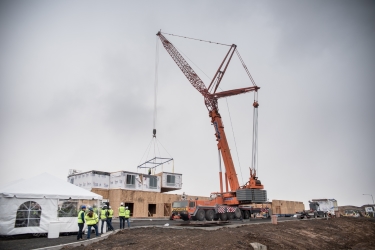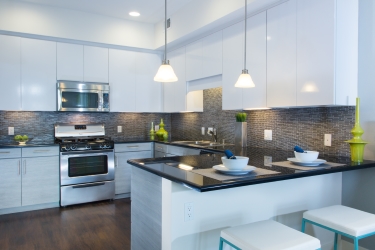|
Subscribe / Renew |
|
|
Contact Us |
|
| ► Subscribe to our Free Weekly Newsletter | |
| home | Welcome, sign in or click here to subscribe. | login |
Construction
| |

December 1, 2016
Modular construction fills the gap as developers want projects faster, contractors deal with labor shortages
Guerdon Enterprises
Modular construction — the process of constructing a building off-site using efficient assembly-line production methods — has evolved far beyond the techniques used to manufacture the mobile homes that first brought the concept to most people's attention.
Today, modular buildings are built to the same codes and standards as conventionally constructed buildings and feature top-quality materials and finishes. Once the modular units are assembled on-site, a modular building is indistinguishable from a traditionally constructed one.
Consistent high quality is ensured through production processes by using experienced personnel with specialized skills and by carefully inspecting every stage.
Depending on the design and the specific project, modular buildings are generally completed 60 to 90 percent off-site with multiple individual modules and then assembled to create larger structures. While Guerdon Enterprises specializes in three- to-five story structures, modular skyscrapers are becoming more common in other parts of the world.
Speed is the most obvious benefit of modular construction. Modular units can be built while the site work is being completed and the foundation prepared, significantly compressing project time lines. Also, controlled factory conditions eliminate weather-related delays, labor issues and other potential interruptions.
Modular construction decreases financing risk, worker injuries, and noise and site disruption. Modular building is also more sustainable, as assembly-line production dramatically decreases material waste and allows for the consistent incorporation of energy-efficient and eco-friendly materials and components.
The more efficient production process reduces the cost of construction and, perhaps even more importantly, makes costs more predictable. Budget certainty is — along with speed — one of the key advantages for developers.
Although much of the discussion of modular building centers on single-family homes, more and more large-scale commercial projects such as hotels, assisted-living facilities and multifamily housing projects are benefiting from modular construction.
Modular multifamily projects are particularly popular in areas with high housing costs, such as the Puget Sound and the San Francisco Bay Area.
One example of a successful multifamily project is Domain Apartments in San Jose, California, which began production in May 2012. This development comprises five four-story buildings containing 431 modular residential units made by Guerdon. The project team chose high-end features to help attract and retain residents, and the modular units arrived from the factory with 9-foot ceilings, granite countertops, stainless steel appliances, and washers and dryers already installed.
The fast-track construction schedule and a phased occupation strategy allowed the developer, Equity Residential, to get a jump on market demand. The first building was occupied within a year of the start of production, and the other four were available for leasing within the next six months. Modular construction enabled the developer to complete the project nine months earlier than traditional building methods would have allowed and to achieve lease stabilization a full year sooner than would otherwise have been possible.
Another modular multifamily development is the Union Flats project developed by Windflower Properties in Union City, California. This sustainable (LEED platinum) project includes 243 apartments and 2,400 square feet of retail space spanning two four-story buildings in the city's Station District. Union Flats is using 408 modular units built in Guerdon's factory in Boise, Idaho. Like Domain Apartments, Union Flats will offer upscale amenities, including a pool and spa, a fitness area, and an outdoor entertainment space.
Union Flats is scheduled for completion next spring — a full year sooner than would have been possible with on-site construction. Speed was critical, as the project had an extremely tight time line. Thanks to the success of the first phase using modular construction, Windflower is planning to use the technology in the second phase.
Modular building methods are moving into the mainstream as more developers embrace the approach and as household names embark on modular projects. For example, Yale University is building modular student housing, Google is proposing modular components in its new headquarters, and Hilton and Marriott are building modular hotels.
Marriott's latest 122-unit Courtyard hotel is being built using modular technology on Washington State University's campus in Pullman. In partnership with Stonebridge Companies and Vandervert Construction, the four-story, 76,000-square-foot hotel will be built using Guerdon's modular construction technology, with all rooms and finishes made exactly to Courtyard by Marriott specifications. It is among the first Marriott hotels to be built using modular construction processes.
In 2017, the continuing shortage of skilled labor in some areas, as well as the higher labor costs involved in on-site construction, will further strengthen demand for modular construction.
Areas with acute housing shortages will see particularly high levels of adoption, as developers seek to meet the demand as quickly as possible.
And as more developers work with the technology, they will come to appreciate the greater control that the process offers, thanks to assured time frames, fixed costs and consistent product quality.
Lad Dawson is CEO of Guerdon Enterprises. Dawson started the company in 2001 to make factory technology the mainstream building method for modular residential and commercial construction projects.
Previous columns:
- With air excavation tools, it doesn't have to be a battle of trees versus construction, 11-17-2016
- Historic work trucks on display in Tacoma: Their tiny size and ingenuity may surprise you, 11-10-2016
- New scholarship’s aim: create project managers and superintendents through UW online program, 11-03-2016
- Get sleepy on the job? $200 SmartCap wakes you up, 10-27-2016
- Lakeside's first female superintendent, Marque Craig, says times have changed, 10-20-2016
- Aging county jails become grimmer, more dangerous as funding problems persist, 10-13-2016
- Alaska Power lays its first major undersea fiber link; like adding a 28,000-lane road, 10-06-2016
- Filing a claim for extra work? Contractors still bear the burden of complying with notice requirements, 09-29-2016




